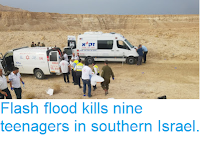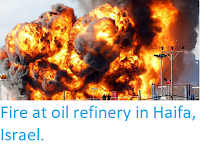Eleven people have died in a series of flash flood incidents across Jordan as a series of storms swept across the Middle Eastern country this week. Full details of the casualties have not yet become available, but the deaths are known to include two women and a girl who were in a vehicle swept off the road by floodwaters in Dabaa, where at least one other person died in a separate incident, and nine people have been admitted to hospitals with flooding related injuries. Another child has been confirmed dead in Madaba Province, and around 3600 tourists had to be evacuated from the ancient city of Petra when the area was hit by flooding.
Flood damage near Madaba in Jordan this week. Petra News Agency/EPA.
Like many desert areas, Jordan, while generally arid, is
prone to occasional severe flooding. This stems from two causes; firstly
the arid climate prevents the development of a thick soil layer which
would be expected in less dry areas, so that in much of the area
(non-porous) bedrock is either exposed or close to the surface, and
secondly the hot climate leads to heavy evaporation from nearby seas and
oceans, so that if the wind changes direction and brings water-laden
air to the area, it brings a lot of precipitation with it. This
combination of heavy rainfall and low ground absorbency leads to large
amounts of water at the surface, typically moving downhill at some
speed. Wadis, dry channels or ravines through which these sudden floods
are channelled, can be particularly dangerous at these times,
particularly as they often appear to resemble natural pathways or even
camp sites to people unfamiliar with the climate.
See also...
Follow Sciency Thoughts on Facebook.







